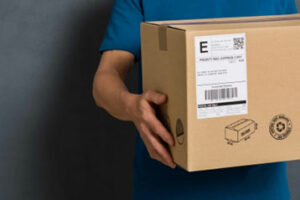Key Trends Impacting the Label Industry
Sustainability and availability are changing the label industries in profound and interconnected ways.

When placed on recyclable materials, like this shipping box, fiber-based, thermal facestock can typically be recycled at most recycling centers. Image courtesy of Pixelle Specialty Solutions.
By Mark Comensoli, Sales Director at Pixelle Specialty Solutions
A greater focus on sustainability initiatives is driving the label industry to evaluate the environmental impact of its products. Many companies are setting goals with 2025 deadlines and considering the entire life cycle of their products and packaging, even after consumer use. As a critical part of packaging, labels can attract consumers to products or help identify and track products through warehousing and shipping. Once packaging has served its purpose, it — and the label on it — are discarded.
To reduce the environmental impact of their products, many manufacturers are focusing on circularity within the label industry by recycling and using post-consumer content. Yet, there are service and supply limitations that can prevent access to readily available solutions. As a result, manufacturers are taking a multipronged approach to improve sustainability and circularity in the label industry through new, innovative products that minimize waste and improve recyclability.
Increasing recyclability and minimizing landfill impact

Release liners for pressure-sensitive labels that use innovative barrier technologies can break down more easily and are more widely recyclable than release liners that use poly-coatings. Image courtesy of Pixelle Specialty Solutions.
Once a label is produced, what is its end state? Unfortunately, most labels today end up in a landfill. This is because many recycling systems in the U.S. don’t have the capabilities to manage multipart or nonstandard materials. Although label recycling does exist, recycling capabilities differ from municipality to municipality. Organizations such as CELAB and the Tag & Label Manufacturers Institute (TLMI) are supporting label recycling efforts, and TLMI offers recycling location maps for matrix byproducts and PET and paper release liners.
While continuing to develop infrastructure and supply chains for the recycling of these materials will be key, label manufacturers are changing the way labels are made, to reduce environmental impact and improve circularity from the start. To understand the recyclability of a label and how quickly it breaks down, it’s important to consider what materials it’s made from. While most cut-and-stack labels found in the food and beverage industry are typically fiber-based monomaterials that can be recycled with paper, pressure-sensitive labels can contain several materials that may not be accepted in the recycling stream and take time to break down in a landfill.
Developing new innovations
Pressure-sensitive labels have four elements: facestock with pressure-sensitive adhesive and a liner with a release coating. Sometimes the release coating is a poly-coating. There are very few recycling facilities for release liners, which means most liners go to the landfill. Some release liners are poly-coated and as polymeric film does not readily break down it makes the recycling efforts even more difficult.
To improve the circularity of these labels, some specialty manufacturers are developing alternatives. One alternative is to add recycle fiber to the release liner and another alternative is the development of barrier technologies for release liners that break down more easily than poly-coatings and thus would be more widely recyclable. By producing release liners that can be recycled in more widely available recycling centers, label manufacturers can improve circularity and reduce waste.
Another way specialty label manufacturers are reducing waste is by reducing the amount of material a label contains in the first place. Two ways they are doing this is through downgauging the weight of specialty release liners and producing linerless solutions. Downgauging minimizes the amount of material required to produce a specialty release liner while maintaining performance, which can reduce the amount of accumulated release liner waste. Linerless solutions, on the other hand, are self-adhesive label products that don’t have release liners at all, and specialty label manufacturers are innovating facestock to meet the rigors of linerless requirements.
Improving circularity

Fiber-based cut-and-stack labels can be recycled with paper at most recycling centers. Image courtesy of Pixelle Specialty Solutions.
A truly circular economy requires a closed loop. For labels, this means that post-consumer recycled content can be made into new labels. Right now, facestock with 30% post-consumer waste is available, but use is not yet widespread in the industry because there is a limited supply of it. The lack of recycled fiber supply results in high costs. If the cost was closer to virgin fiber, there would likely be greater adoption.
Why is there such limited supply? Labels and release liners tend to be highly engineered, with stringent performance standards and customer expectations. Most recycled fiber doesn’t have the qualities of a new fiber; it loses its strength and gets dirtier as it goes through the recycle process, which can impact label performance. To produce and offer high-quality post-consumer waste label products and ultimately create a truly circular label economy, the industry will require a greater availability of high-quality recycled pulp.
As companies seek to reduce the environmental impact of their labels and improve the circularity of their economies, it’s important that they partner with a specialty paper manufacturer with a proven paper-making legacy and an extensive portfolio of innovative, responsible solutions. It’s important that manufacturers hold forest certifications to ensure products are sourced from well-managed forests so that forests can be enjoyed by future generations.
Innovating toward a more sustainable future
Driven by the sustainability goals of major companies, the label industry is moving toward a circular, more sustainable economy from many different directions. However, achieving success requires new label innovations, stronger label recycling infrastructure and greater high-quality reprocessed material availability. Critical products such as release liner barrier technologies, release liners with lower weights and linerless solutions are essential for moving the industry forward — toward greater label circularity and a more sustainable future.
About the Author
Mark Comensoli is a Sales Director for Pixelle Specialty Solutions. He has worked in the paper and film converting industry for 24 years, bringing sales, finance and market strategy experience to Pixelle. In his role, he takes a consultative approach to providing customers with cohesive solutions that help their businesses run smoothly and become more profitable.








